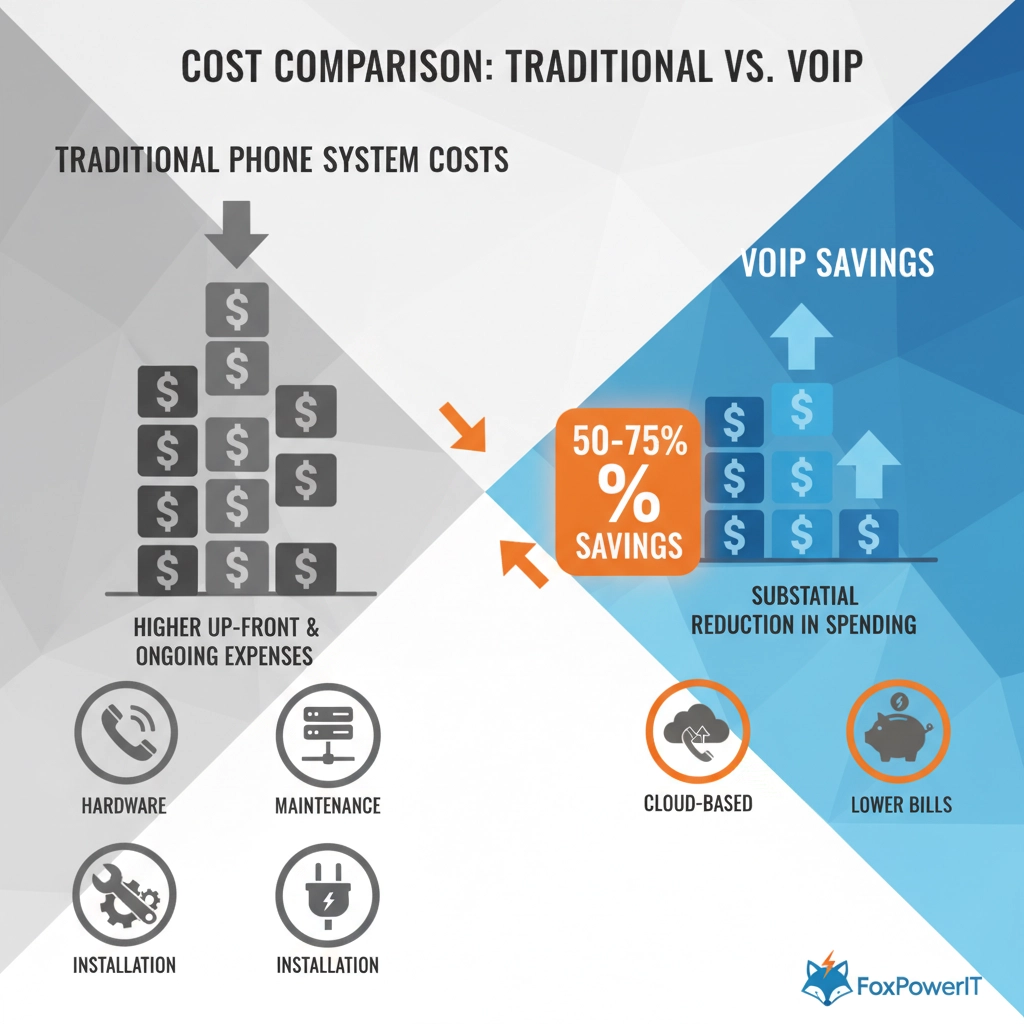That conference call with your biggest donor drops for the third time this week. Your development director can't access voicemail from home. The fax machine that processes critical medical forms hasn't worked since the "upgrade" two months ago. Sound familiar?
If you're a Connecticut nonprofit considering VoIP migration: or worse, currently struggling through a botched transition: you're not alone. What should be a straightforward technology upgrade often becomes an operational nightmare when organizations underestimate the complexity involved.
The promise is compelling: slash your phone bills by 50-75%, support remote work seamlessly, and access modern features your old system never offered. Connecticut nonprofits typically save $3,000-$8,000 annually through VoIP adoption, with some organizations seeing even larger reductions in overhead costs that can be redirected to mission-critical programs.
But here's what the sales presentations don't tell you: VoIP migration is less about replacing phones and more about rebuilding your entire communications infrastructure. The organizations that succeed treat it as a strategic project requiring careful planning, adequate resources, and realistic timelines. Those that fail approach it like buying new office equipment.
After analyzing dozens of VoIP implementations across Connecticut's nonprofit sector: both successful transitions and costly disasters: clear patterns emerge. The same mistakes happen repeatedly, costing organizations thousands in unexpected expenses, staff productivity losses, and donor frustration.
Here are the ten critical lessons learned from nonprofits that wish they could do their VoIP migration over again.
1. "We Thought It Was Just About Replacing Our Phones"
The biggest misconception nonprofit leaders have about VoIP is treating it as an equipment swap rather than an infrastructure transformation. Many organizations approach the project thinking they'll simply unplug their old phones and plug in new ones, maintaining the exact same calling patterns and capabilities they had before.
This mindset leads to missed opportunities and inadequate planning. Modern VoIP systems offer capabilities that didn't exist with traditional phone systems: computer-based call management, smartphone integration, presence indicators showing staff availability, voicemail-to-email delivery, and sophisticated call routing that can follow staff across multiple devices and locations.

Organizations that only focus on duplicating their existing setup waste money on features they'll never use while missing functionalities that could dramatically improve their operations. Your development team could benefit from click-to-dial integration with your donor database, automatically logging call details and scheduling follow-ups. Program staff working across multiple sites could use find-me/follow-me routing to never miss important calls from clients or funders.
The solution starts with conducting a thorough needs assessment that examines not just your current phone usage, but how improved communications could support your mission more effectively. Document who calls whom, when peak calling periods occur, what types of calls different staff members handle, and how communications flow between different programs and locations.
This assessment reveals opportunities for improvement that justify the investment beyond simple cost savings. When you understand VoIP as a platform for better communications rather than just cheaper phone service, you make decisions that serve your organization for years rather than just addressing immediate budget pressures.
2. "Our Network Wasn't Ready and We Didn't Know It"
VoIP systems don't just need internet connectivity: they require properly engineered network infrastructure with specific capabilities many nonprofits don't have. The most common technical failure point is assuming that if you can browse websites and send emails, your network can handle voice traffic.
Voice calls are far more demanding than typical data usage. They require consistent, low-latency connections with minimal packet loss, and they need guaranteed bandwidth allocation through Quality of Service (QoS) protocols. Without these configurations, voice traffic competes with file downloads, video streaming, and software updates, resulting in choppy audio, dropped calls, and frustrated users.
Your data switches must support VLANs and QoS capabilities, and these features must be properly configured before your VoIP system will work reliably. Many older switches lack these capabilities entirely, requiring hardware upgrades that can cost thousands of dollars: expenses that catch organizations off guard when they're not identified during initial planning.

Power considerations create another hidden infrastructure requirement. Traditional phone systems typically continue working during power outages because they receive power through the telephone lines themselves. VoIP phones receive power through your network switches via Power over Ethernet (PoE), meaning your entire communications system goes down when you lose power unless your network equipment is protected by sufficient battery backup systems.
Cable quality and distance limitations also surprise organizations. VoIP phones require at least Cat5e cabling and must be located within 328 feet of their supporting switch. Nonprofits operating in older buildings or across multiple locations often discover that their existing cabling infrastructure can't support IP phones without significant upgrades.
The lesson here is to conduct thorough network assessments before committing to VoIP migration. Professional IT evaluations identify these requirements upfront, allowing you to budget appropriately and avoid discovering expensive surprises mid-implementation.
3. "We Forgot About All Our Analog Devices"
Digital transformation sounds comprehensive until you realize how many analog devices your organization depends on without thinking about them. Most nonprofits significantly underestimate the number of analog connections they're supporting beyond their obvious desk phones.
Fax machines top the list of forgotten devices. While everyone talks about going paperless, the reality is that many nonprofits still process critical paperwork via fax: medical forms, government documents, signed contracts, and applications that legally require fax transmission. These devices need traditional analog phone lines and won't work if simply connected to IP phone systems.
Security systems, door entry controls, elevator emergency phones, fire alarm monitoring, and equipment alert systems also typically require analog connections. When these systems stop working after VoIP implementation, you face not just operational disruptions but potential safety and liability issues.

Credit card processing equipment, copier/printer fax capabilities, and alarm monitoring systems represent other commonly overlooked analog dependencies. Some nonprofits discover that their postage meters, time clocks, or specialized program equipment also rely on phone line connectivity.
While these devices can be supported through separate analog lines outside your main phone system, this solution becomes expensive and impractical when you have many devices. Some VoIP systems include analog gateways that can support these devices, but these capabilities must be specified and planned for during system design.
The solution is conducting a comprehensive audit of every device in your organization that currently connects to phone lines. Walk through each building and location, checking equipment rooms, reception areas, kitchens, and storage areas where analog devices might be installed and forgotten. Document each device, its current phone line requirements, and how it will be supported in your new VoIP environment.
4. "We Skimped on Staff Training and Paid for It Later"
Modern VoIP systems bring capabilities most staff have never encountered, but many vendors have shifted away from comprehensive training to save costs. The assumption that "anyone can use a phone" ignores the reality that IP phones and their associated software applications require hands-on learning to become productive tools.
Basic functions like transferring calls, accessing voicemail, and managing call routing work differently on VoIP systems than traditional phones. Advanced features like voicemail-to-email delivery, presence indicators, find-me/follow-me routing, computer-based dialing, and smartphone integration require training to become valuable rather than frustrating.
Organizations that rely solely on online training videos or brief orientation sessions find that staff members either don't use advanced features (wasting the investment) or use them incorrectly (creating operational problems). When your development director can't figure out how to transfer a major donor to the executive director, or when program staff miss important calls because they haven't configured their mobile integration properly, inadequate training becomes a mission-critical problem.

The productivity loss during the learning curve also gets underestimated. Even with good training, staff need time to build muscle memory for new procedures and to integrate advanced features into their daily workflows. Organizations that implement VoIP during peak operational periods: like during fundraising campaigns or program enrollment periods: compound the challenge by forcing staff to learn new systems while managing critical responsibilities.
Quality VoIP providers include comprehensive staff training through live sessions, both group webinars and individual coaching. This training should cover not just basic phone operations but also the specific features that support your organization's workflows. Your donor management staff need different training than your program delivery teams.
Budget for adequate training time and plan implementation during slower operational periods when staff can focus on learning new systems. Consider appointing "phone champions" in different departments who receive advanced training and can provide ongoing peer support.
5. "Number Porting Became Our Bottleneck"
Maintaining your existing phone numbers sounds straightforward until you discover the complexity of actually transferring them from your old provider to your new VoIP system. Organizations that don't plan adequately for number porting can experience weeks of service disruptions or situations where different numbers become active at different times.
Professional VoIP providers handle number porting as part of standard service, but the process itself requires coordination between your old and new providers and typically takes longer than anticipated. Some numbers port quickly while others encounter regulatory delays or technical complications. Organizations sometimes discover that certain numbers can't be ported at all due to carrier restrictions or regulatory requirements.
The timing coordination becomes particularly complex. Your old system must remain active until porting completes, but your new system needs to be ready to receive the numbers when they transfer. This overlap period requires paying for both systems simultaneously and coordinating cutover schedules that minimize disruption to normal operations.

Toll-free numbers often have different porting requirements than local numbers, and some nonprofits discover that their memorable fundraising numbers or helpline numbers face additional regulatory hurdles. Organizations with multiple locations may find that different numbers port at different rates, creating confusion for callers and staff.
The solution is starting the porting process early and maintaining realistic timelines. Professional providers begin porting requests as soon as contracts are signed, allowing weeks for completion rather than assuming it happens overnight. They also provide clear communication about which numbers are scheduled to port when, allowing organizations to plan transition communications accordingly.
Develop backup plans for critical numbers that might experience porting delays. Consider temporary call forwarding solutions or alternative contact methods for essential services during transition periods.
6. "We Didn't Understand the Compliance Requirements"
Connecticut nonprofits face specific regulatory requirements that must be maintained during VoIP migration, and many organizations don't realize these requirements exist until they're out of compliance. E911 emergency location services top the list of critical compliance areas that work differently with VoIP systems than traditional phones.
Traditional phone systems automatically provide emergency responders with your physical location when you dial 911. VoIP systems require proper configuration to transmit accurate address information, and this becomes complex for organizations operating from multiple locations or supporting remote workers. Misconfigured systems could send emergency responders to your main office when someone calling from a satellite location or home office needs help.
The Connecticut Data Privacy Act creates additional compliance requirements for organizations handling personal information, and phone system records often contain protected data. VoIP systems typically offer more detailed call logging and recording capabilities than traditional phones, requiring organizations to understand their data retention obligations and privacy protection requirements.
Healthcare-focused nonprofits face HIPAA compliance requirements that extend to their communications systems. VoIP systems must include appropriate security measures and access controls when handling protected health information, and not all providers offer HIPAA-compliant service levels.

Organizations receiving federal funding may face additional telecommunications compliance requirements, and some grants specifically restrict how communications funds can be spent. VoIP systems must meet these requirements while still delivering the cost savings that justify the investment.
Working with state-approved VoIP providers through programs like the CRCOG contract helps ensure compliance requirements are met from day one. These providers understand Connecticut's specific regulatory environment and configure systems to meet state requirements automatically. However, organizations must still understand their specific compliance obligations and verify that their VoIP configuration addresses them appropriately.
7. "We Misunderstood the True Cost Picture"
While VoIP delivers significant long-term savings, the migration itself incurs upfront costs that catch many nonprofits unprepared. Beyond monthly service fees, organizations must budget for network infrastructure upgrades, equipment purchases, professional installation, staff training time, and potential productivity losses during transition.
The 50-75% reduction in monthly phone bills that most organizations achieve represents real money that can be redirected to programs, but this savings doesn't begin until after successful implementation. Organizations that don't budget adequately for transition costs sometimes compromise on essential elements like proper infrastructure preparation or comprehensive training, ultimately undermining the long-term benefits.
Network infrastructure upgrades represent the largest unexpected expense category. Organizations discover they need new switches, additional battery backup systems, cable upgrades, or wireless improvements to support VoIP reliably. These costs can run from hundreds to thousands of dollars depending on your current infrastructure condition and the complexity of your requirements.
Equipment costs also vary significantly depending on your approach. Organizations that choose to purchase phones outright face higher upfront costs but lower monthly fees, while those who lease equipment or select hosted solutions spread costs over time but pay more long-term. The right choice depends on your cash flow situation and technology refresh preferences.

Connecticut nonprofits have unique advantages through the CRCOG VoIP contract, which provides automatic 20% discounts on monthly services for CRCOG IT Sharing Plan members and eliminates lengthy RFP processes. These benefits significantly improve the cost equation, but even with discounts, organizations must budget for transition expenses.
Professional installation and project management fees ensure proper implementation but add to upfront costs. Organizations that try to minimize these expenses sometimes discover that inadequate installation creates ongoing operational problems that cost more to fix than proper implementation would have cost initially.
The key is developing comprehensive budgets that account for both obvious and hidden costs, then planning cash flow to cover transition expenses while maintaining operational funding for your programs.
8. "Our Implementation Timeline Was Completely Unrealistic"
Professional VoIP implementations typically require 2-4 weeks from contract signing to full deployment, but nonprofits often assume they can compress this timeline or skip planning phases to meet arbitrary deadlines. Rushing the process leads to incomplete configurations, insufficient testing, and staff overwhelmed by learning new systems while managing critical responsibilities.
The implementation process includes several phases that can't be safely compressed: current system assessment, infrastructure evaluation, equipment ordering and configuration, installation scheduling, staff training, testing periods, and cutover coordination. Each phase depends on completing previous steps properly, and skipping elements creates problems that surface later.
Organizations that try to implement during busy operational periods compound the challenge. Attempting VoIP migration during fundraising campaigns, program enrollment periods, or grant application deadlines forces staff to learn new systems while managing peak workloads, practically guaranteeing productivity losses and user frustration.

Professional installations happen during planned maintenance windows with thorough testing before switching systems live. This includes assessment of current systems to determine what equipment can be reused, careful installation of necessary hardware upgrades, comprehensive system configuration and testing, and coordination with number porting timelines.
The most successful implementations occur during slower operational periods when staff can focus on learning new systems and when temporary disruptions have minimal impact on critical activities. This requires planning months ahead rather than waiting until your current system fails completely or budget pressures force immediate action.
Build realistic timelines that account for each implementation phase, including adequate time for staff training and system familiarization. Consider the operational calendar when scheduling cutover dates, avoiding peak activity periods and ensuring key staff will be available during transition.
9. "We Underestimated Our Call Volume Needs"
Legacy phone systems hit hard capacity limits: when all physical lines are occupied, additional calls get busy signals or go straight to voicemail. During fundraising drives, crisis response periods, or program enrollment campaigns, this means missed donations, frustrated clients, and lost opportunities to serve your mission.
Many nonprofits don't understand their actual calling patterns because traditional phone systems don't provide detailed usage analytics. Organizations discover during their first major fundraising campaign that they need significantly more concurrent call capacity than their basic VoIP service plan provides, but scaling up during peak demand periods often isn't possible on short notice.
VoIP systems can handle significantly more concurrent calls through cloud infrastructure, with most providers supporting 10-20 simultaneous calls per organization as a baseline. However, organizations must analyze their peak demand requirements and select appropriate service tiers rather than assuming basic packages will handle all situations.
The flexibility advantage of VoIP systems is that capacity can often be scaled up temporarily during peak periods without hardware changes, but this capability must be planned and arranged in advance. Organizations can't wait until they're in the middle of their annual giving campaign to discover they need additional capacity.

Call routing sophistication also affects capacity utilization. Smart routing rules can distribute calls more efficiently across available staff, reducing wait times and busy signals even with the same number of concurrent call slots. Features like callback queuing allow callers to request callbacks rather than waiting on hold, effectively expanding your apparent capacity.
Analyze your historical calling patterns, identifying peak periods and maximum concurrent usage. Plan VoIP capacity to handle these peaks with margin for growth, and understand your provider's policies for temporary capacity increases during special campaigns or events.
10. "We Forgot About Remote Work Integration"
VoIP systems naturally support distributed teams through smartphone apps, computer software, and web-based interfaces that maintain full functionality regardless of physical location. Staff can access the complete phone system from home offices, satellite locations, or while traveling for program delivery, reducing overhead while expanding your talent pool beyond commuting distance.
However, organizations that don't plan for remote capabilities from the start often discover that adding them later requires system reconfigurations, additional licensing costs, or complete service tier upgrades. With remote work now standard rather than exceptional, failing to incorporate these capabilities into initial planning means missing a primary advantage of VoIP systems.
The integration goes beyond just making and receiving calls remotely. Modern VoIP systems allow remote staff to appear in office directories, participate in call routing rules, access voicemail through email, and maintain professional presence indicators showing their availability status. These features help remote workers integrate seamlessly into organizational communications rather than feeling isolated or disconnected.
Remote capabilities also support program delivery models that weren't possible with traditional phone systems. Case managers can maintain consistent contact numbers while working across multiple sites. Development staff can conduct donor calls from anywhere while maintaining professional presentation through office number display and call recording capabilities.

Security considerations become important for remote VoIP usage. Staff accessing phone systems from home networks and public Wi-Fi connections need appropriate security protocols to protect organizational communications. Some VoIP providers offer enhanced security features specifically designed for remote users, including encrypted communications and secure authentication methods.
Training requirements expand when supporting remote users. Staff need to understand not just office phone operations but also smartphone app functionality, computer software usage, and troubleshooting common home network issues that can affect call quality.
Plan for remote capabilities as a core requirement rather than an afterthought. Evaluate different VoIP providers' remote support features, security offerings, and user training resources. Consider the long-term advantages of supporting flexible work arrangements for staff recruitment and retention.
Making Your VoIP Migration Successful
VoIP migration represents more than cost savings: it's an investment in communications infrastructure that can transform how your organization operates and serves its mission. The key lies in treating the project strategically rather than tactically, investing in proper planning, infrastructure assessment, comprehensive training, and realistic implementation timelines.
The nonprofits that succeed with VoIP migration start by understanding their true communications needs, not just their current phone usage patterns. They invest in proper infrastructure preparation, comprehensive staff training, and professional implementation support. Most importantly, they plan for capabilities they'll need in the future rather than just replicating what they had in the past.
Connecticut nonprofits have significant advantages through programs like the CRCOG contract, which provides automatic discounts and simplified procurement processes. However, these benefits only deliver value when organizations approach VoIP migration with adequate preparation and realistic expectations.
Start your VoIP evaluation by assessing current phone costs and communication patterns, identifying opportunities for improvement beyond just cost reduction. Contact approved providers to understand your options and develop comprehensive budgets that account for both obvious and hidden implementation costs.
Most importantly, learn from the experiences of organizations that struggled through unprepared migrations. The money saved through VoIP: redirected from overhead back to program delivery: makes the effort worthwhile, but only when you avoid the pitfalls that derail inadequately planned projects.
The technology is proven, the savings are real, and the operational benefits are significant. Success depends on approaching VoIP migration as the strategic infrastructure project it actually is rather than the simple vendor swap it appears to be.
For more information about VoIP solutions for Connecticut nonprofits, visit FoxPowerIT to learn how professional managed IT services can ensure your communications upgrade supports your mission effectively.

